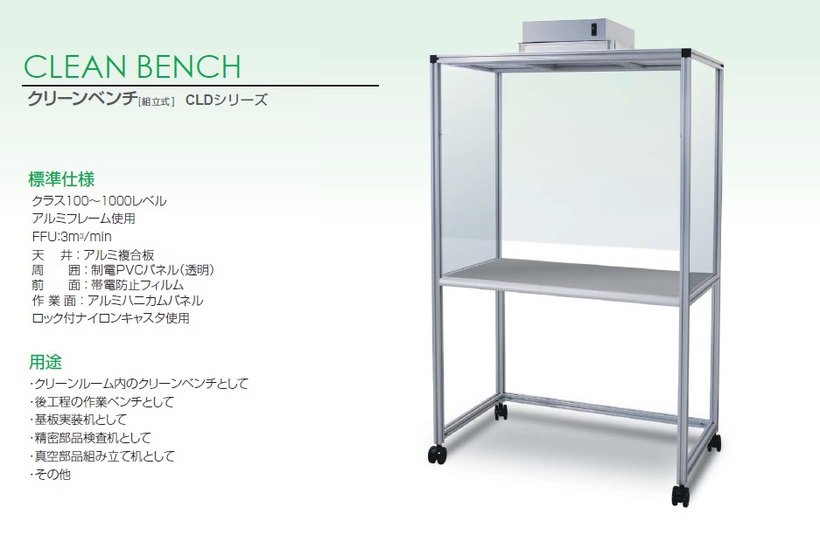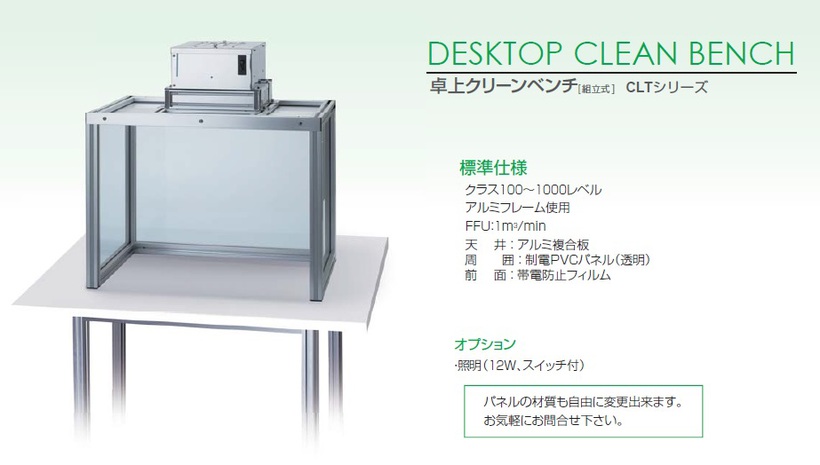A clean bench is an enclosed workbench that is controlled to prevent dirt and dust in the air and surrounding environment from adhering to or contaminating items that are being worked on. Clean air that has passed through a high-performance air filter (HEPA filter) flows directly to the item being worked on, which makes it possible to maintain a high degree of cleanliness even in locations that have a low level of cleanliness. They are used mainly in factories and laboratories.
Although there is a similar device called a "safety cabinet", clean benches also provide an internal positive pressure. Therefore, it is possible to create a very clean state that is free from dust by discharging air to the outside of the enclosure.
Types of Clean Benches
Various functions are added to clean benches according to the work to be performed.
Built-in type
Floor-standing units are built into equipment without the workbench.
Drying type
This type includes an infrared lamp for performing drying on the workbench.
Vibration-free type
This type has a gap between the workbench and the main unit, preventing the direct transmission of vibration.
Light table type
This type combines a fluorescent lamp with an acrylic or glass workbench.
Water supply/drainage type
The workbench, or a section of it, includes a sink with a faucet at the front.
Exhaust type
This type enables air exhaust from the workbench, or a section of it.
Circulation type
This type circulates clean air.
Principles of Clean Benches
The clean bench is a workbench designed to ensure that the top of the bench is clean. It is constructed with a clean box unit on top of the bench. It is a box-shaped enclosure that consists of and walls on the front, top, and both sides. Workers place their hands inside the enclosure to perform work. Air pulled in from the outside is filtered to remove dirt and dust, and then the clean air is sent inside the bench.
There are two types of clean benches: a horizontal blower type that blows air forward from the front surface, and a vertical blower type that blows air downward from the top surface. In the case of horizontal blowers, the air might collect around the worker's arms or the equipment, preventing a sufficient level of cleanliness. Therefore, Matsusada Precision clean benches primarily use vertical blowers. Horizontal blowers can be provided upon request.
The structure of clean benches is determined according to regulations in JIS B9922.
JIS B9922 Regulations
- Structure that can be easily maintained, inspected, and adjusted
- Walls in the workspace do not easily peel or form rust
- Structure that prevents unfiltered air from entering the work area
- Structure that allows the clean bench to be connected to a ground wire
- HEPA or ULPA filter used as the main air filter
- Filter that does not degrade or corrode easily under normal air conditions, and is easily detached for maintenance and/or replacement
- In the case of sectors that handle acids, organic solvents, biological particles, toxic gases, etc., structure that allows air containing such substances to be ventilated along the required exhaust route
- Explosion-proof structure as specified in JIS C 0903
- For models that are equipped with both normal lighting and sterilization lamps, both types of lighting should not be lit at the same time unless specifically agreed upon by the user.
How to Use a Clean Bench
It is very easy to use a clean bench. After washing your hands thoroughly, use alcohol to disinfect your hands and then all of the items to be used inside the clean bench. Turn on the filter switch, and insert your hands into the insertion ports to perform the work. There are also clean benches that have a completely open front, or that have a shutter to be pulled down. If the clean bench has a shutter, pull it down as far as possible while still allowing you to perform the work.
Points to Consider When Choosing a Clean Bench
Before choosing a clean bench, clearly determine how you intend to use the equipment. Clearly identifying the intended use will make it easier to choose the appropriate product.
- Does it fit the intended use?
- Will it fit into the installation space?
- Is it within your budget?
- Do the cleanliness, airflow, and weight satisfy the required specifications?
- Does it have sufficient dust collection efficiency?
Recommended Clean Benches
Matsusada Precision clean benches can be designed as needed according to intended use and available installation space. Our products use strong yet lightweight aluminum frames, and are equipped with casters so they can be moved easily after installation. They can be introduced easily and at low cost.




